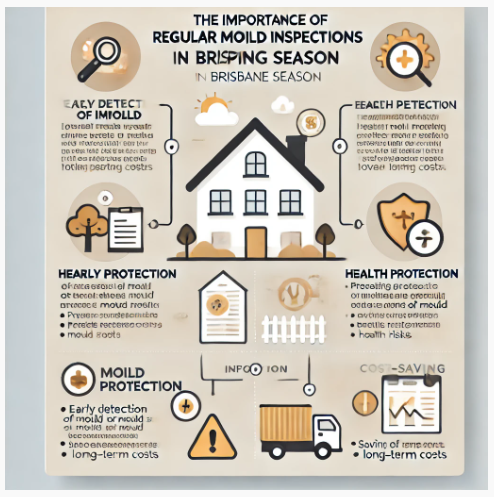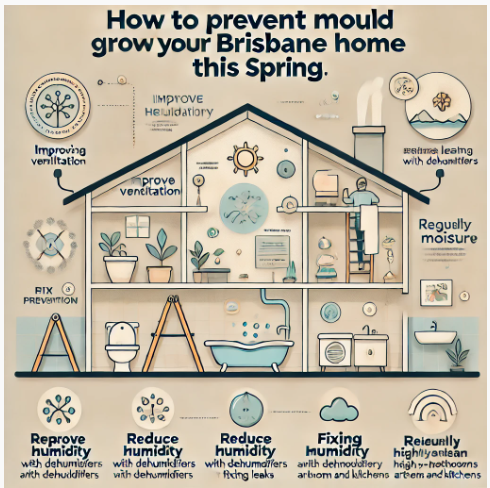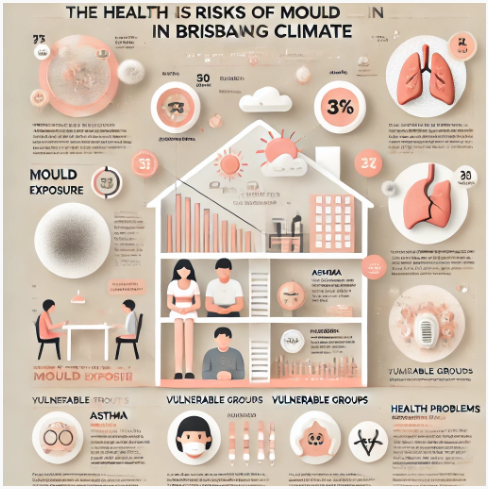The Importance of Regular Mould Inspections in Brisbane’s Spring Season
Spring in Brisbane is a beautiful season, but it also brings increased humidity and frequent rainfall. These conditions create a perfect environment for mould growth in homes, especially those with poor ventilation or existing moisture issues. Regular mould inspections are essential in managing mould risks, particularly in Brisbane’s spring climate.
This article explores why regular inspections are important, the benefits of early detection, and how inspections save homeowners money and health concerns.
Why Mould Grows Quickly in Brisbane’s Spring Climate
Mould growth is directly linked to moisture and warmth, both of which increase during Brisbane’s spring months. According to the Australian Bureau of Meteorology, Brisbane’s average humidity in spring is about 70%, and frequent rainfall adds to the already moist environment. High humidity levels make it easier for mould spores to settle on damp surfaces and begin growing.
Mould spores are present in the air at all times, and they only need moisture to become active. Once they find a suitable environment, spores can develop within 24 to 48 hours. If left undetected, mould can spread quickly, causing damage to walls, ceilings, and floors, and posing health risks for residents.
Common Areas Where Mould Grows
Mould is more likely to grow in areas where moisture builds up. In Brisbane, some of the most common areas affected by mould include:
- Bathrooms: Bathrooms are exposed to constant moisture from showers and baths. Steam and condensation create damp conditions, especially on walls, tiles, and ceilings.
- Kitchens: Cooking and washing create moisture, and poor ventilation can trap this dampness, leading to mould growth on walls, under sinks, and behind appliances.
- Basements and crawl spaces: These areas often lack ventilation and tend to retain moisture, making them prime spots for mould to grow.
- Roofs and gutters: Rainwater and leaks can lead to mould growth in ceilings and walls, especially when gutters are clogged or damaged.
Regular inspections help detect early signs of mould in these areas, reducing the risk of extensive infestations.
The Health Risks of Undetected Mould
Mould is not just a visual problem; it can pose serious health risks. When mould is left untreated, it releases spores into the air, which can trigger allergies, respiratory issues, and infections. Queensland Health warns that mould exposure can lead to symptoms such as coughing, wheezing, and skin irritation, especially in people with asthma or respiratory conditions.
According to Asthma Australia, mould is a major asthma trigger, and up to 80% of people with asthma are allergic to mould spores. For those with weakened immune systems, including children and the elderly, exposure to mould can lead to respiratory infections and other health complications. Regular inspections are essential to keep homes safe and minimise these health risks.
The Financial Costs of Mould Damage
Undetected mould can lead to costly repairs if it spreads through walls, ceilings, or floors. The Insurance Council of Australia estimates that mould-related damage can cost homeowners between $5,000 and $15,000 on average to repair, depending on the extent of the infestation. In some severe cases, repairs can exceed $30,000 if mould has damaged structural elements like timber beams or insulation.
Regular mould inspections are a small investment compared to the potential cost of repairs. By detecting and treating mould early, homeowners can avoid extensive structural damage and save money in the long run.
Benefits of Regular Mould Inspections
Routine mould inspections offer several important benefits, including early detection, health protection, and long-term cost savings. Here’s how regular inspections can make a difference:
1. Early Detection Prevents Spread
Mould spreads quickly, and early detection is essential to stop it from covering larger areas. Regular inspections allow professionals to identify early signs of mould and address them before they become severe.
At Reliance Mould Solutions, our inspections include a thorough assessment of moisture levels, ventilation, and possible mould growth areas. By catching problems early, we prevent infestations that could otherwise lead to costly repairs.
2. Improves Indoor Air Quality
Mould releases spores that circulate in the air, leading to poor indoor air quality. These spores can trigger allergic reactions, asthma attacks, and other respiratory problems. According to CSIRO, poor indoor air quality due to mould can increase the risk of respiratory infections, especially in Brisbane’s humid climate.
Regular inspections and removal services help improve air quality by removing mould sources and reducing the number of spores in the air. This leads to a healthier home environment, especially for those with asthma or allergies.
3. Reduces Health Risks
Mould exposure is linked to various health problems, from mild allergic reactions to severe respiratory issues. Regular inspections are crucial for minimising health risks, particularly for people with pre-existing conditions. Asthma Australia notes that homes with visible mould are at a higher risk for asthma attacks and respiratory problems.
A professional inspection identifies mould growth early and removes it safely, protecting household health and preventing the spread of harmful spores.
Why Brisbane’s Spring Climate Increases Mould Risk
Brisbane’s spring climate is warm and humid, with average temperatures between 20°C and 30°C and frequent rainfall. These conditions create a perfect environment for mould to grow. Rainfall increases moisture levels indoors, especially if windows are left open or if homes have leaks. High humidity means that moisture remains in the air, allowing mould to thrive.
A report by the Australian Institute of Health and Welfare found that homes in humid areas, like Brisbane, have higher rates of respiratory problems due to increased indoor mould growth. Regular inspections are essential in these environments to catch mould early and prevent it from spreading.
What to Expect During a Professional Mould Inspection
A professional mould inspection is more than just a visual check. At Reliance Mould Solutions, our inspectors use specialised tools and methods to detect even the smallest signs of mould growth.
1. Moisture Detection
Mould thrives in damp areas, so our inspectors use moisture metres to detect high moisture levels in walls, ceilings, and floors. This helps identify hidden mould growth that may not be visible to the naked eye.
2. Air and Surface Sampling
To determine the extent of mould growth, our team collects air and surface samples. These samples are analysed to detect the type and concentration of mould spores present in the home. This data is essential for developing a targeted treatment plan.
3. Detailed Report and Recommendations
After the inspection, we provide a detailed report outlining our findings and recommending solutions. This report includes moisture readings, areas of concern, and suggested treatments to remove mould and prevent future growth.
Why DIY Inspections Are Not Enough
Many homeowners try to inspect for mould themselves, but DIY inspections are limited. Surface checks may reveal visible mould, but they often miss hidden growth behind walls or in poorly ventilated areas. DIY inspections also lack the tools needed to measure moisture or detect airborne spores accurately.
A CSIRO study found that homes with DIY mould checks were more likely to develop recurrent mould problems, as DIY methods typically fail to address the underlying cause. Professional inspections are comprehensive and help prevent recurring issues by targeting moisture and ventilation problems.
The Long-Term Savings of Regular Inspections
Investing in regular mould inspections provides long-term savings for homeowners. By catching mould early, inspections help prevent structural damage, reduce the need for costly repairs, and improve indoor air quality. For Brisbane homeowners, where spring conditions heighten mould risks, regular inspections are an essential part of home maintenance.
Conclusion: Protect Your Home with Regular Mould Inspections
Spring in Brisbane brings increased humidity and moisture, both of which contribute to higher mould risks. Regular mould inspections are essential for early detection, health protection, and long-term cost savings. By investing in routine inspections, you can prevent mould from becoming a serious issue in your home.
At Reliance Mould Solutions, we offer comprehensive inspections and treatments to keep your home safe and mould-free. Contact us today to schedule your spring mould inspection and protect your home from Brisbane’s humid climate.
Please see our article on Why Mould Growth Surges In Spring



